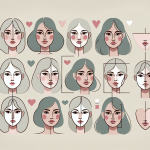Types Of Dimples
Dimples are a naturally occurring indentation on the skin that can be found on various parts of the body, but are most commonly found on the cheeks. They are formed when the skin is attached to the underlying connective tissue and muscle, creating a small depression or indentation. Dimples are often considered an attractive physical characteristic and are sought after by many people.
There are different types of dimples, including cheek dimples, chin dimples, and back dimples. Cheek dimples are the most common type and are formed when the zygomaticus major muscle pulls on the skin, creating a small depression. Chin dimples, also known as cleft chins, are formed when the skin is attached to the underlying bone, creating a small crease or line. Back dimples, also known as Venus dimples, are formed when the skin is attached to the underlying ligaments and tendons, creating two small indentations above the buttocks.
Understanding the different types of dimples and their characteristics can help individuals appreciate their unique physical features. While dimples are often associated with beauty standards, it is important to recognize that physical appearance should not be the sole determinant of an individual’s worth. Dimples are just one of the many physical characteristics that make each person unique.
Key Takeaways
- Dimples are a naturally occurring indentation on the skin that are often considered an attractive physical characteristic.
- There are different types of dimples, including cheek, chin, and back dimples, each with their own unique characteristics.
- While dimples are often associated with beauty standards, it is important to recognize that physical appearance should not be the sole determinant of an individual’s worth.
The Science of Dimples

Dimples are small indentations found on the skin, most commonly on the cheeks. They are considered a genetic trait and are inherited from parents. The zygomaticus major muscle is responsible for the formation of dimples.
Genetic Factors
Dimples are considered a dominant trait, meaning that if one parent has dimples, there is a 50% chance that their child will also have them. If both parents have dimples, the chances increase to 75%. However, if neither parent has dimples, the chances of their child having them are very low.
Facial Musculature
The zygomaticus major muscle is responsible for the formation of dimples. This muscle is located in the cheek and is responsible for raising the corners of the mouth when a person smiles. In people with dimples, this muscle is shorter than in people without dimples, which causes the skin to indent when they smile.
In conclusion, dimples are a genetic trait that is inherited from parents. The zygomaticus major muscle is responsible for the formation of dimples, and in people with dimples, this muscle is shorter than in people without dimples.
Types of Dimples
Dimples are small indentations that can occur on different parts of the body, including the cheeks, chin, and lower back. They are considered a sign of beauty and are often admired. In this section, we will explore the different types of dimples and their characteristics.
Cheek Dimples
Cheek dimples, also known as dimples of Venus, are the most common type of dimple. They are located on the lower part of the cheeks and are caused by a small defect in the zygomaticus major muscle. When a person smiles, the skin around the muscle moves, creating a visible indentation on the cheek. Cheek dimples are considered an attractive feature and are often associated with youthfulness.
Chin Dimples
Chin dimples, also known as cleft chins, are a small line on the chin that stays on the chin without making any specific facial expressions. They are caused by a small defect in the mentalis muscle, which is responsible for controlling the movement of the lower lip and chin. Chin dimples are often considered a desirable feature and are associated with strength and beauty.
Back Dimples
Back dimples, also known as dimples of Venus or sacral dimples, are located on the lower back, just above the buttocks. They are caused by a small defect in the sacroiliac joint, which is the joint that connects the spine to the pelvis. Back dimples are often considered a sign of good health and fitness, and are admired by many.
In addition to the above-mentioned dimples, there are other types of dimples that are less common. For instance, fovea mentalis is a small indentation that occurs on the chin when a person pouts. It is caused by a small defect in the mentalis muscle. While it is not as well-known as other types of dimples, it is still considered an attractive feature.
In conclusion, dimples are a unique and beautiful feature that can occur on various parts of the body. Cheek, chin, and back dimples are the most common types, and are often associated with beauty and youthfulness. While other types of dimples are less common, they are still admired by many and can add to a person’s overall attractiveness.
Dimples and Beauty Standards
Cultural Perceptions
Dimples have been a part of cultural beauty standards for centuries. In some cultures, dimples were considered a sign of good luck, while in others, they were seen as a symbol of beauty and youthfulness. However, the perception of dimples has changed over time and varies across cultures.
In Western culture, dimples are often seen as an attractive feature, especially in women. They are often associated with cuteness and innocence. On the other hand, in some Asian cultures, dimples are not considered desirable and are often associated with babyish features.
Celebrities and Influence
Celebrities have played a significant role in shaping beauty standards around the world, and dimples are no exception. Many celebrities, including Ariana Grande, Miranda Kerr, John Travolta, Beyoncé Knowles, and Brad Pitt, are known for their dimples and have helped popularize the feature.
Ariana Grande’s dimples are one of her trademark features, and many of her fans consider them to be cute and endearing. Miranda Kerr’s dimples are often cited as one of the reasons for her success as a model, and they have helped her stand out in a highly competitive industry.
John Travolta’s dimples have been a part of his charm and appeal for decades, and they have helped him become one of Hollywood’s most iconic leading men. Beyonc√© Knowles’ dimples are often mentioned in the media, and many of her fans consider them to be a part of her beauty.
Brad Pitt’s dimples have been a part of his appeal since the beginning of his career, and they have helped him become one of Hollywood’s most desirable leading men. His dimples are often cited as one of the reasons for his success as an actor.
In conclusion, dimples have played a significant role in shaping cultural beauty standards around the world. While their perception has changed over time, they remain a desirable feature for many people. Celebrities have helped popularize dimples, and they continue to be a part of the beauty industry’s standards.
Dimple Variations and Characteristics
Dimples are small, natural indentations in the flesh on a part of the human body, most commonly in the cheek. However, dimples can also appear on other parts of the body, such as the chin and lower back. In this section, we will explore the variations and characteristics of dimples.
Size and Shape
Dimples come in different sizes and shapes. Some dimples are small and barely noticeable, while others are more prominent and deep. The size and shape of a dimple depend on the underlying muscle structure and the amount of fat in the area. Generally, larger and deeper dimples are considered more attractive.
Symmetry and Position
Dimples can be bilateral or unilateral. Bilateral dimples appear on both cheeks, while unilateral dimples appear on only one cheek. The position of a dimple can also vary. Some dimples are located near the mouth corner, while others are situated on the side of the chin. The symmetry and position of a dimple can affect the overall appearance of the face.
In terms of attractiveness, dimples are often associated with positive qualities such as youthfulness, innocence, and charm. However, it is important to note that not everyone finds dimples attractive, and beauty standards vary across cultures and individuals.
Overall, dimples are a unique and fascinating aspect of human anatomy. Whether you have them or not, they are a natural and beautiful feature that adds character to the face.
Creating and Enhancing Dimples
Dimples are considered an attractive feature by many people. If you are not born with dimples, there are ways to create or enhance them. In this section, we will discuss some of the methods that are commonly used to create or enhance dimples.
Dimpleplasty Surgery
Dimpleplasty is a surgical procedure that is used to create dimples. It is a minimally invasive procedure that involves making a small incision inside the cheek and creating a small depression in the muscle. The procedure takes about 30 minutes to complete and is performed under local anesthesia. The recovery time is minimal, and patients can resume their normal activities within a few days.
Dimpleplasty is a permanent solution for creating dimples. However, it is important to note that the results may not be exactly the same as natural dimples. Also, there are risks associated with any surgical procedure, and patients should discuss them with their surgeon before undergoing the procedure.
Temporary Solutions
If you are not ready to undergo surgery, there are some temporary solutions that can be used to enhance the appearance of dimples. Here are some of the methods that can be used:
-
Makeup: Using makeup can create the illusion of dimples. By applying a darker shade of foundation or blush in the area where the dimple is desired, the appearance of a natural dimple can be created.
-
Dimple creation tools: There are some tools available in the market that can be used to create artificial dimples. These tools work by creating a suction in the area where the dimple is desired. However, the results are temporary and may not look natural.
-
Facial exercises: Some people believe that facial exercises can help create or enhance dimples. However, there is no scientific evidence to support this claim.
In conclusion, there are both permanent and temporary solutions available for creating or enhancing dimples. Dimpleplasty surgery is a permanent solution, while makeup, dimple creation tools, and facial exercises are temporary solutions. It is important to discuss all the options with a qualified professional before making a decision.






